Effect of Limestone and Quartz Fillers in UHPC with Calcined Clay
Abstract
:1. Introduction
2. Experimental Investigation
2.1. Materials
- An ASTM C 1157 Type HS cement (HS), with a Blaine fineness of 438 m2/kg, a mean particle size of 14 µm (0.4–80.0 µm), and a density of 3.18 g/cm3.
- An ASTM C 618 Metakaolin (MK), with a BET-specific surface area of 10.66 m2/g, a mean particle size of 14 µm (0.4–70.0 µm), and a density of 2.59 g/cm3.
- An ASTM C 994 Type A polycarboxylate based high range water reducer or superplasticizer (HRWRA), with a density of 1.09 g/cm3 and an active agent content of 40%.
- Quartz Powder (Q) with a mean particle size of 19 µm (2.0–80.0 µm), and a density of 2.75 g/cm3.
- Limestone Powder (L) with a mean particle size of 17 µm (0.6–400.0 µm), and a density of 2.71 g/cm3.
- An ASTM C 33 natural river sand with 5 mm maximum size (80.0 µm–5.0 mm), a density of 2.61 g/cm3 and an absorption of 1.15%.
2.2. Mixture Proportions
- Approximately ninety percent of the water volume and all the other ingredients were added to the bowl.
- The initial mixing consisted of 4 min at 104 rpm, during this time is believed that the aggregates play a role at breaking powders conglomerates.
- After the initial mixing, the mixer was turned off for a period of one minute. The SP-HRWRA was mixed in the remaining volume of water to facilitate its homogenization with the other ingredients when pouring it into the mixing bowl at the end of the rest period. The delayed dosage of the admixture avoids the entrapment of the polycarboxylate chains within the first cement hydration products and improves its performance [15].
- From minute sixth to tenth, the speed of the mixer was shifted to 194 rpm.
- Finally, mixing continues at a speed of 353 rpm for 5 min, for a total mixing time of 15 min.
2.3. Test Methods
- Elemental chemical composition—PANalytical X-ray Fluorescence Sprectometer, model Axios.
- Particle Size Distribution—Malvern Mastersizer 2000.
- Density—Quantachrome, Multi Pycnometer.
- Blaine Fineness—Slimatic by Interlab.
- BET specific surface area—Micromeritics ASAP 2020 Plus.
- Thermogravimetric analyses (TGA) were performed using TA instruments SDT Q600, on paste fractions reproduced from the proportions of mixtures that presented similar compressive strengths at 91 days, M15, M15L and M15Q. For this purpose, the pastes were pulverized by grinding, until the whole powder passes the sieve with a nominal opening of 150.0 µm (No. 100), and subsequently the solvent exchange method with isopropanol and diethyl ether was used to freeze the hydration process. The tests were carried out on 50 mg samples with a ramp of 10 °C/min within a temperature range of 25 to 1000 °C and a nitrogen flow of 50 mL/min. The data is processed using the universal analysis software TA 2000.
- TGA investigations allowed the determination of bound water and the mass loss corresponding to the portlandite decomposition. The principle is based on the measurement on the change of mass of the sample as a function of time and temperature.
3. Experimental Results and Discussion
3.1. Compressive Strength
3.2. Bulk Electrical Resistivity (BER)
3.3. Thermogravimetric Analysis
3.4. X-ray Diffraction
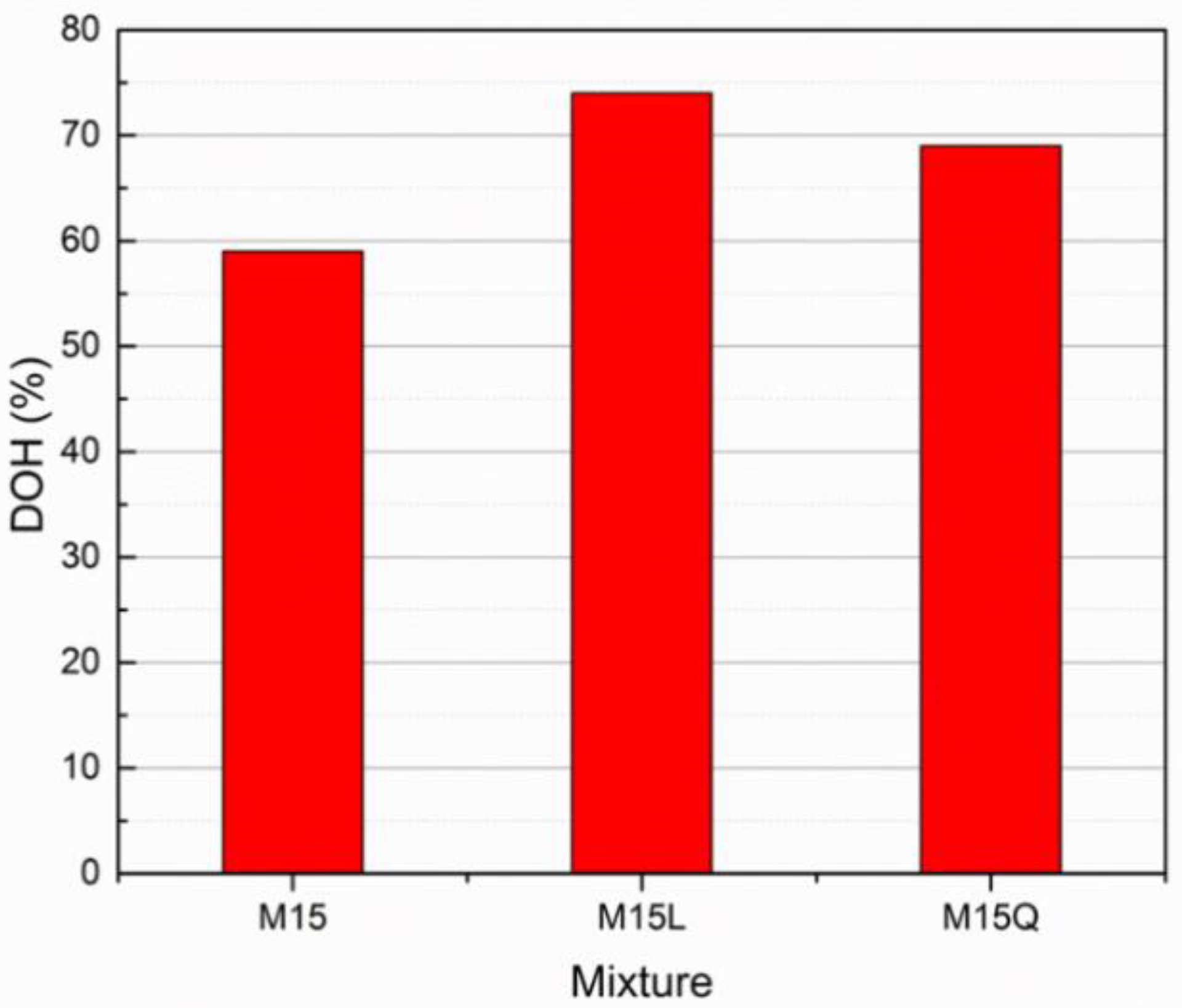
3.5. X-ray Spectroscopy
3.6. Comparison in Cost and Environmental Impact
| Material | UHPC with SF | UHPC with MK | ||||
|---|---|---|---|---|---|---|
| Proportions (MT/m3) | Cost (USD/m3) | CO2 Emissions (kg-CO2/m3) | Proportions (MT/m3) | Cost (USD/m3) | CO2 Emissions (kg-CO2/m3) | |
| OPC | 0.79 [36] | 91.64 | 734.7 | 0.50 | 58 | 465 |
| SF | 0.20 [36] | 52.00 | 1.6 | ------- | ------- | ------- |
| MK | ------ | ------- | ------- | 0.12 | 30 | 47.16 |
| L | ------ | ------- | ------- | 0.25 | 1.25 | 0 |
| Total | 0.99 | 143.64 | 736.3 | 0.87 | 89.25 | 512.16 |
4. Conclusions
- In terms of compressive strength and sustainability, the UHPC that presented the best performance was the one with a metakaolin addition of up to 15% by mass of cement of metakaolin and with a substitution of 37.5% of the cement volume, by either limestone or quartz filler. Higher additions of metakaolin are ineffective.
- As a durability index, the bulk electrical resistivity indicates that metakaolin addi-tions between 10% and 20% by mass of the cement, significantly improves the ability of these concretes to resist chloride ion penetration and to reach the highest level of imperviousness considered in AASHTO T358 (negligible for BER > 127 KΩ·cm), since an age of 70 days or later.
- Results of TGA revealed that the hydration of both, cement and metakaolin, is very active between 7 and 28 days, and dormant at later ages, as well as that the substitu-tion of cement by limestone or quartz fillers (37.5% by volume), improves the hydra-tion reaction and as a result of the significant cement reduction that also decreased the amount of portlandite by 15%.
- XRD results indicate that the low water-cement ratio and the high reactivity of me-takaolin didn’t allow the formation of monocarboaluminate.
- From the QEDS it was possible to quantify the increased aluminum incorporation at 15% MK, passing from a normal C-A-S-H Al/Ca ratio of 0.05 to 0.20. Both quartz and limestone filler replaced samples yield to the same type of C-A-S-H.
Author Contributions
Funding
Institutional Review Board Statement
Informed Consent Statement
Acknowledgments
Conflicts of Interest
References
- Mengxi, D.; Yu, R.; Feng, Y.; Wang, S.; Zhou, F.; Shui, Z.; Gao, X.; He, Y.; Chen, L. Possibility and advantages of producing an ultra-high performance concrete (UHPC) with ultra-low cement content. Const. Build. Mat. 2021, 273, 122023. [Google Scholar] [CrossRef]
- Li, P.P.; Brouwers, H.J.H.; Chen, W.; Yu, Q. Optimization and characterization of high-volume limestone powder in sustainable ultra-high performance concrete. Const. Build. Mat. 2020, 272, 118112. [Google Scholar] [CrossRef]
- Graybeal, B.A. Material Property Characterization of Ultra-High Performance Concrete; FHWA: Washington, DC, USA, 2006; p. 186.
- Scrivener, K.L.; John, V.M.; Gartner, E.M. Eco-efficient cements: Potential, economically viable solutions for a low-CO2, cement-based materials industry. Cem. Conc. Res. 2018, 114, 2–26. [Google Scholar] [CrossRef]
- Sun, Y.; Yu, R.; Wang, S.; Zhou, Y.; Zeng, M.; Hu, F.; Shui, Z.; Rao, B.; Yuan, S.; Luo, Z.; et al. Development of a novel eco-efficient LC2 conceptual cement based ultra-high performance concrete (UHPC) incorporating limestone powder and calcined clay tailings: Design and performances. J. Clean. Prod. 2021, 315, 128236. [Google Scholar] [CrossRef]
- Korpa, A.; Kowald, T.; Trettin, R. Phase development in normal and ultra-high performance cementitious systems by quantitative X-ray analysis and thermoanalytical methods. Cem. Concr. Res. 2009, 39, 69–76. [Google Scholar] [CrossRef]
- Dale, P.; Bentz, A.; Edgardo, F.; Irassar, B.; Bucher, B.; Jason, W. Limestone Fillers to Conserve Cement in Low w/cm Concretes: An Analysis Based on Powers’ Model. Concr. Int. 2009, 31, 41–46. [Google Scholar]
- Schulze, S.E.; Rickert, J. Suitability of natural calcined clays as supplementary cementitious material. Cem. Concr. Compos. 2019, 95, 92–97. [Google Scholar] [CrossRef]
- Huang, W.; Kazemi-Kamyab, H.; Sun, W.; Scrivener, K. Effect of replacement of silica fume with calcined clay on the hydration and microstructural development of eco-UHPFRC. Mater. Des. 2017, 121, 36–46. [Google Scholar] [CrossRef]
- Antoni, M.; Rossen, J.; Martirena, F.; Scrivener, K. Cement substitution by a combination of metakaolin and limestone. Cem. Concr. Res. 2012, 42, 1579–1589. [Google Scholar] [CrossRef]
- Nadelman, E.I.; Kurtis, K.E. Application of Powers’ model to modern portland and portland limestone cement pastes. J. Am. Ceram. Soc. 2017, 100, 4219–4231. [Google Scholar] [CrossRef]
- Jensen, O.M.; Hansen, P.F. Water-entrained cement-based materials I. Principle and theoretical background. Cem. Concr. Res. 2000, 31, 647–654. [Google Scholar] [CrossRef]
- ASTM C230/C230M-20; Standard Specification for Flow Table for Use in Tests of Hydraulic Cement. ASTM International: West Conshohocken, PA, USA, 2020.
- Bakera, A.T.; Alexander, M.G. Use of metakaolin as a supplementary cementitious material in concrete, with a focus on durability properties. RILEM Tech. Lett. 2019, 4, 89–102. [Google Scholar] [CrossRef] [Green Version]
- Tue, N.V.; Ma, J.; Orgass, M.; Fehling, E. Influence of addition method of superplasticizer on the properties of fresh UHPC. In Proceedings of the 2nd International Symposium on Ultra-High Performance Concrete, Kassel, Germany, 5–7 March 2008; pp. 93–100. [Google Scholar]
- Snellings, R.; Bazzoni, A.; Scrivener, K. The existence of amorphous phase in Portland cements: Physical factors affecting Rietveld quantitative phase analysis. Cem. Concr. Res. 2014, 59, 139–146. [Google Scholar] [CrossRef]
- Scrivener, K.; Snellings, R.; Lothenbach, B. A Practical Guide to Microstructural Analysis of Cementitious Materials; CRC Press: Boca Raton, FL, USA, 2016; ISBN 9781138747234. [Google Scholar]
- Aïtcin, P.-C. 3—Portland cement. In Science and Technology of Concrete Admixtures; Aïtcin, P.-C., Flatt, R.J., Eds.; Woodhead Publishing: Cambridge, UK, 2015; pp. 27–51. ISBN 9780081006931. [Google Scholar]
- Avet, F.; Scrivener, K. Investigation of the calcined kaolinite content on the hydration of Limestone Calcined Clay Cement (LC3). Cem. Concr. Res. 2018, 107, 124–135. [Google Scholar] [CrossRef]
- Huang, W.; Kazemi-Kamyab, H.; Sun, W.; Scrivener, K. Effect of cement substitution by limestone on the hydration and microstructural development of ultra-high performance concrete (UHPC). Cem. Concr. Compos. 2017, 77, 86–101. [Google Scholar] [CrossRef]
- Morris, W.; Moreno, E.; Sagüés, A. Practical evaluation of resistivity of concrete in test cylinders using a Wenner array probe. Cem. Concr. Res. 1996, 26, 1779–1787. [Google Scholar] [CrossRef]
- Kunther, W.; Ferreiro, S.; Skibsted, J. Influence of the Ca/Si ratio on the compressive strength of cementitious calcium–silicate–hydrate binders. J. Mater. Chem. A 2017, 5, 17401. [Google Scholar] [CrossRef] [Green Version]
- Prochoń, P.; Piotrowski, T. Bound water content measurement in cement pastes by stoichiometric and gravimetric analyses. J. Build. Chem. 2016, 1, 18–25. [Google Scholar] [CrossRef]
- Cyr, M.; Trinh, M.; Husson, B.; Casaux-Ginestet, G. Effect of cement type on metakaolin efficiency. Cem. Concr. Res. 2014, 64, 63–72. [Google Scholar] [CrossRef]
- Puerta-Falla, G.; Balonis, M.; Le Saout, G.; Neithalath, N.; Sant, G. The Influence of Metakaolin on Limestone Reactivity in Cementitious Materials. In Calcined Clays for Sustainable Concrete, Proceedings of the 1st International Conference on Calcined Clays for Sustainable Concrete, Lausanne, Switzerland, 23–25 June 2015; RILEM Bookseries; Springer: Dordrecht, The Netherlands, 2015. [Google Scholar]
- Stetsko, Y.P.; Shanahan, N.; Deford, H.; Zayed, A. Quantification of supplementary cementitious content in blended Portland cement using an iterative Rietveld-PONKCS technique. J. Appl. Crystallogr. 2017, 50, 498–507. [Google Scholar] [CrossRef]
- Avet, F.; Li, X.; Scrivener, K. Determination of the amount of reacted metakaolin in calcined clay blends. Cem. Concr. Res. 2018, 106, 40–48. [Google Scholar] [CrossRef]
- Arend, J.; Wetzel, A.; Middendorf, B. Fluorescence Microscopic Investigations of the Retarding Effect of Superplasticizers in Cementitious Systems of UHPC. Materials 2020, 13, 1057. [Google Scholar] [CrossRef] [PubMed] [Green Version]
- Escalante-Garcia, J.I.; Mendoza, G.; Sharp, J. Indirect determination of the Ca/Si ratio of the C-S-H gel in Portland cements. Cem. Concr. Res. 1999, 29, 1999–2003. [Google Scholar] [CrossRef]
- Wilson, W.; Rivera-Torres, J.; Sorelli, L.; Durán-Herrera, A.; Tagnit-Hamou, A. The micromechanical signature of high-volume natural pozzolan concrete by combined statistical nanoindentation and SEM-EDS analyses. Cem. Conc. Res. 2017, 91, 1–12. [Google Scholar] [CrossRef]
- Avet, F.; Boehm-Courjault, E.; Scrivener, K. Investigation of C-A-S-H composition, morphology and density in Limestone Calcined Clay Cement (LC3). Cem. Concr. Res. 2019, 115, 70–79. [Google Scholar] [CrossRef]
- Rintala, A.; Havukainen, J.; Abdulkareem, M. Estimating the Cost-Competitiveness of Recycling-Based Geopolymer Concretes. Recycling 2021, 6, 46. [Google Scholar] [CrossRef]
- Díaz, Y.C.; Berriel, S.S.; Heierli, U.; Favier, A.; Machado, I.R.S.; Scrivener, K.L.; Hernández, J.F.M.; Habert, G. Limestone calcined clay cement as a low-carbon solution to meet expanding cement demand in emerging economies. Dev. Eng. 2017, 2, 82–91. [Google Scholar] [CrossRef]
- Hammond, G.; Jones, C. Inventory of Carbon and Energy, 2nd ed.; University of Bath: Bath, UK, 2011. [Google Scholar]
- Yu, J.; Lu, C.; Leung, C.K.; Li, G. Mechanical properties of green structural concrete with ultrahigh-volume fly ash. Constr. Build. Mater. 2017, 147, 510–518. [Google Scholar] [CrossRef]
- Ullah, R.; Qiang, Y.; Ahmad, J.; Vatin, N.I.; El-Shorbagy, M.A. Ultra-High-Performance Concrete (UHPC): A State-of-the-Art Review. Materials 2022, 15, 4131. [Google Scholar] [CrossRef]
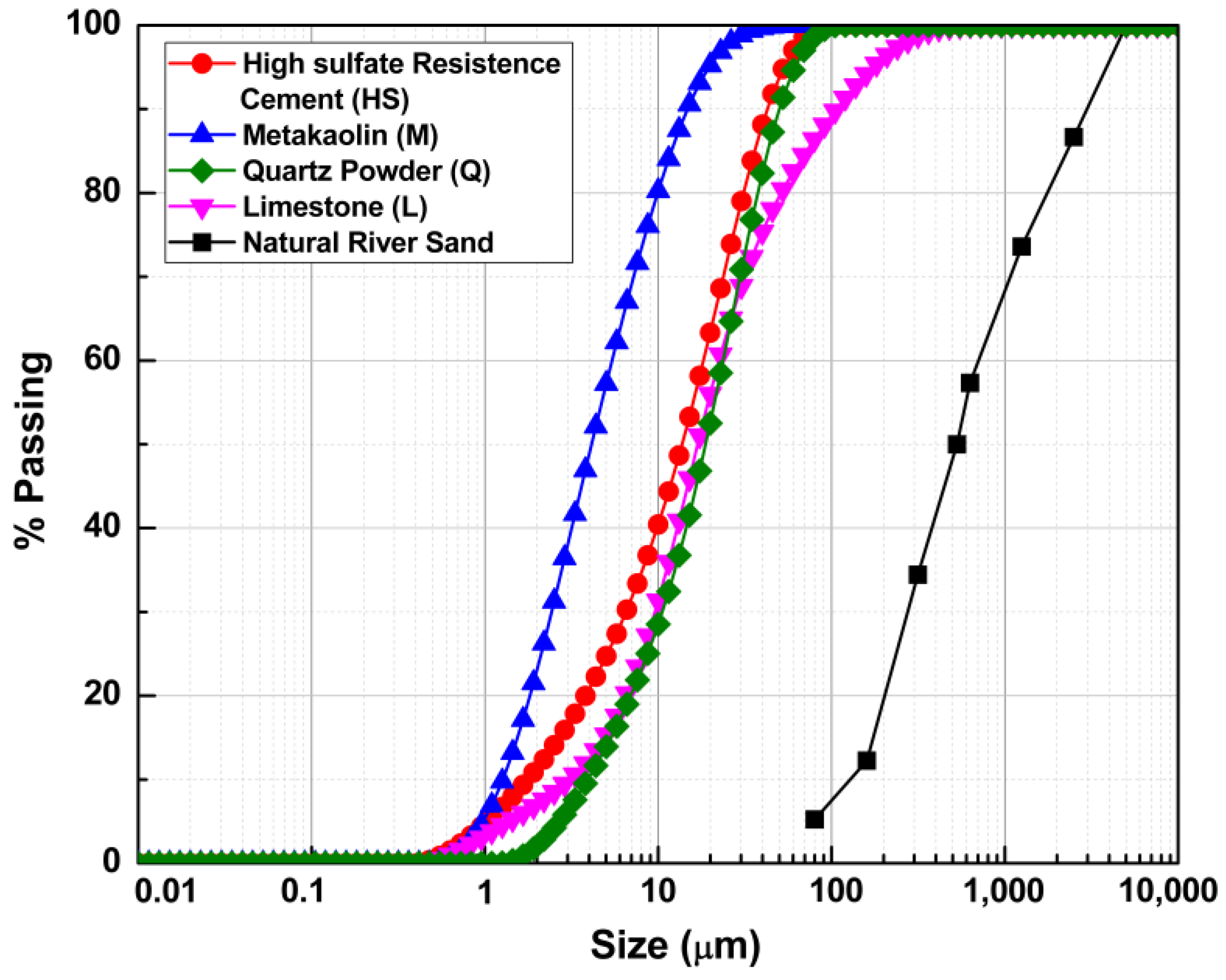
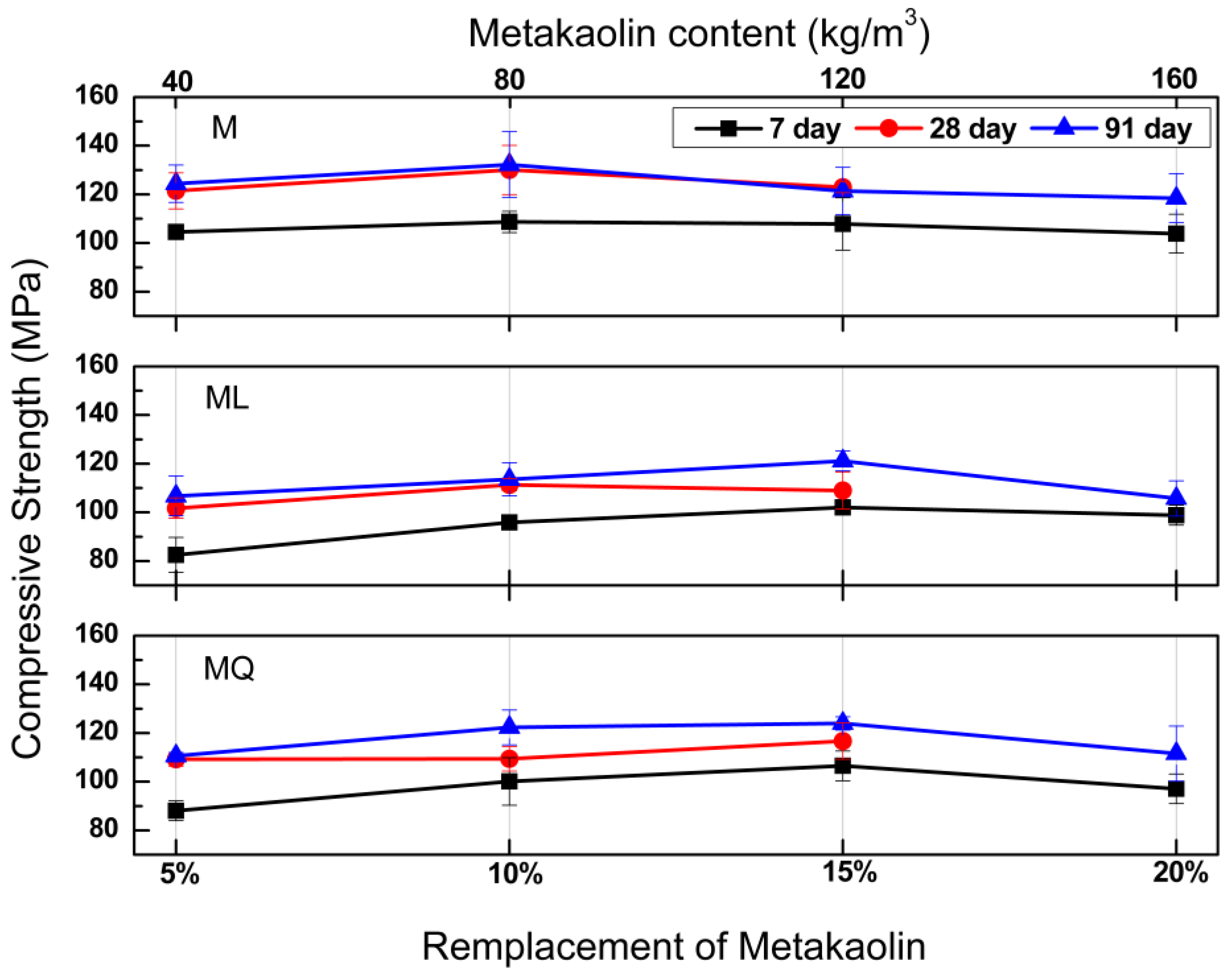
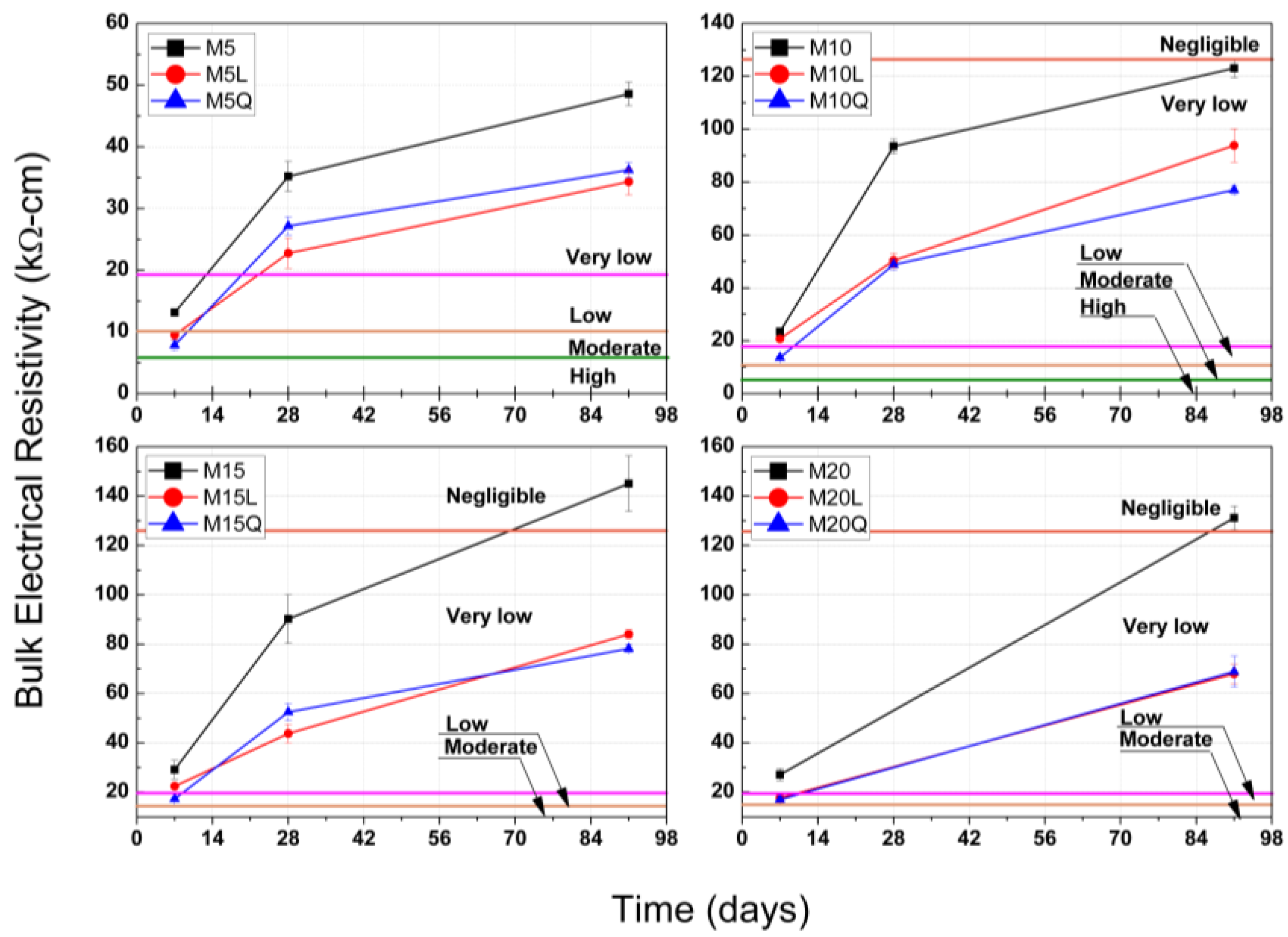

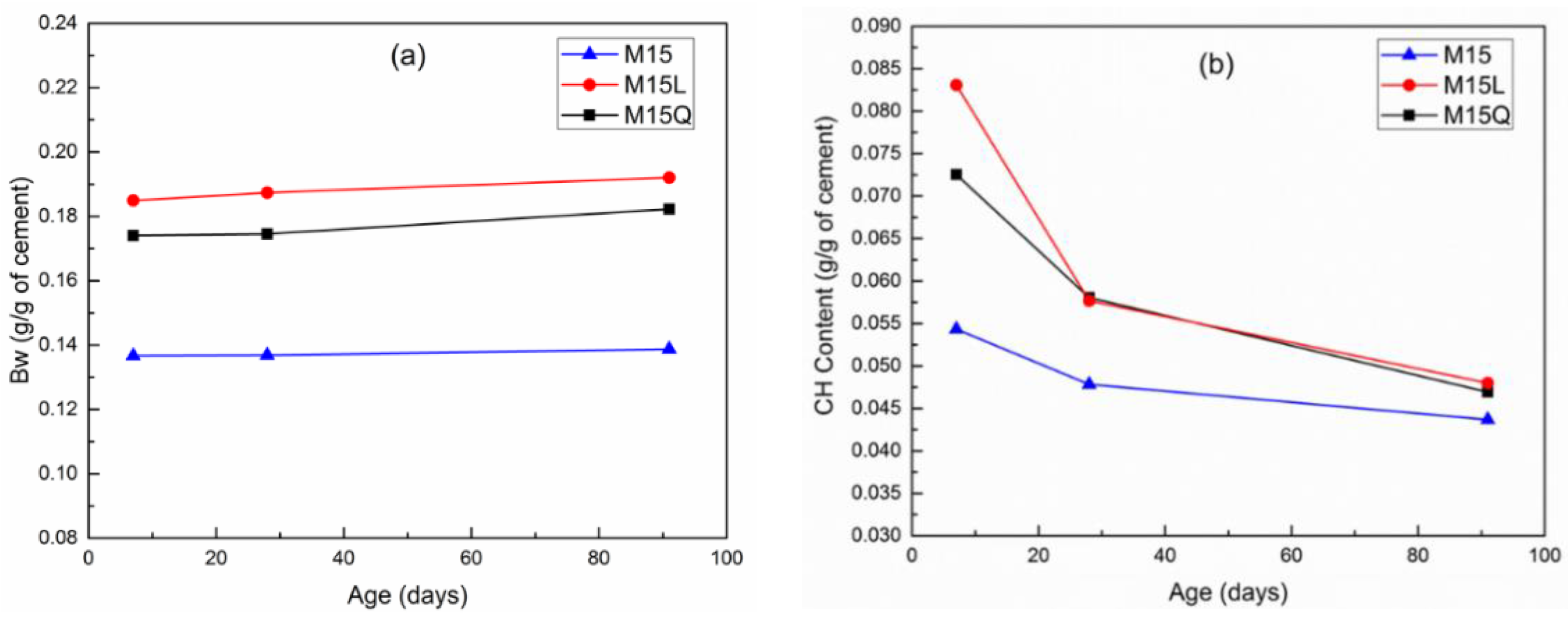
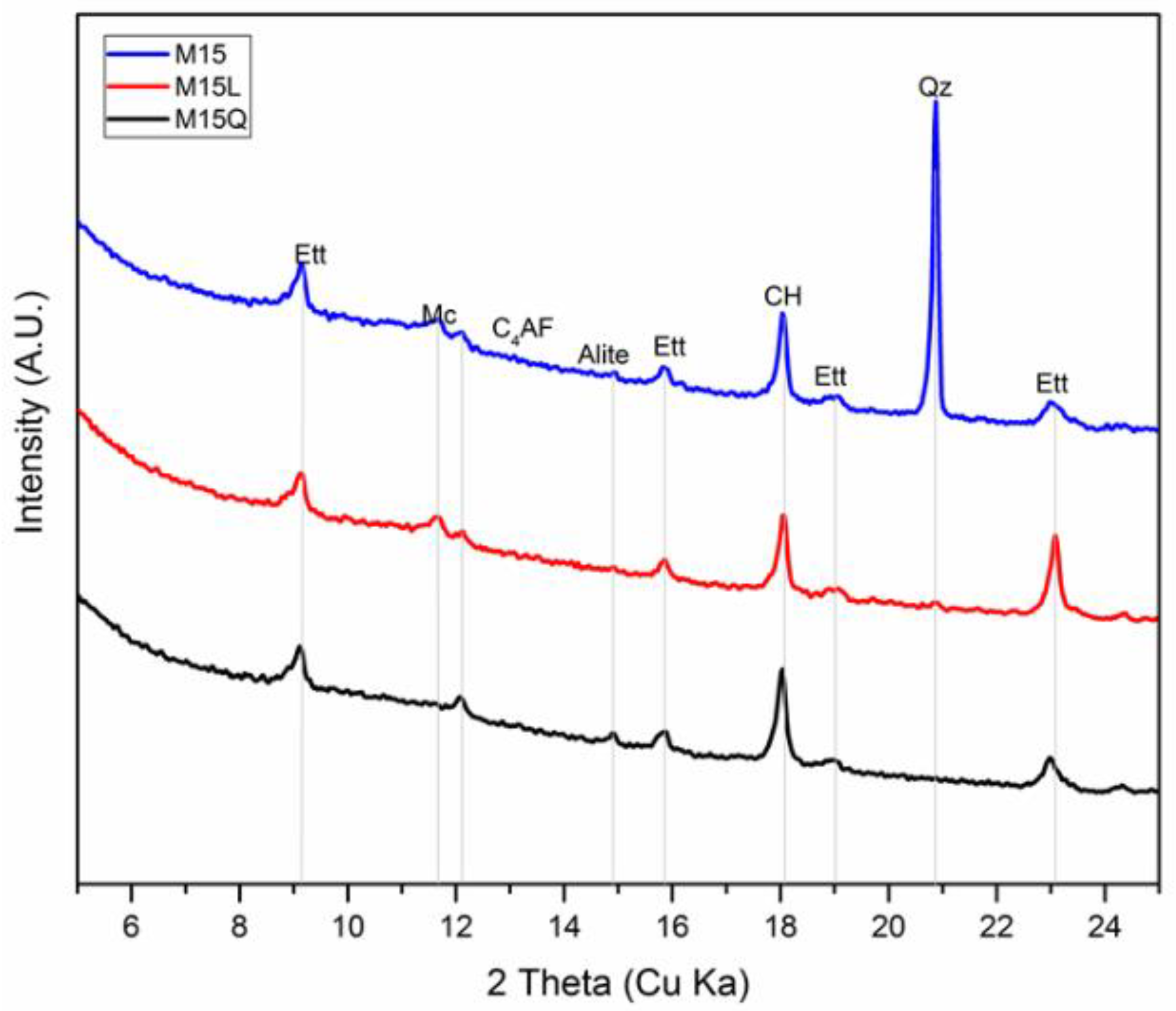
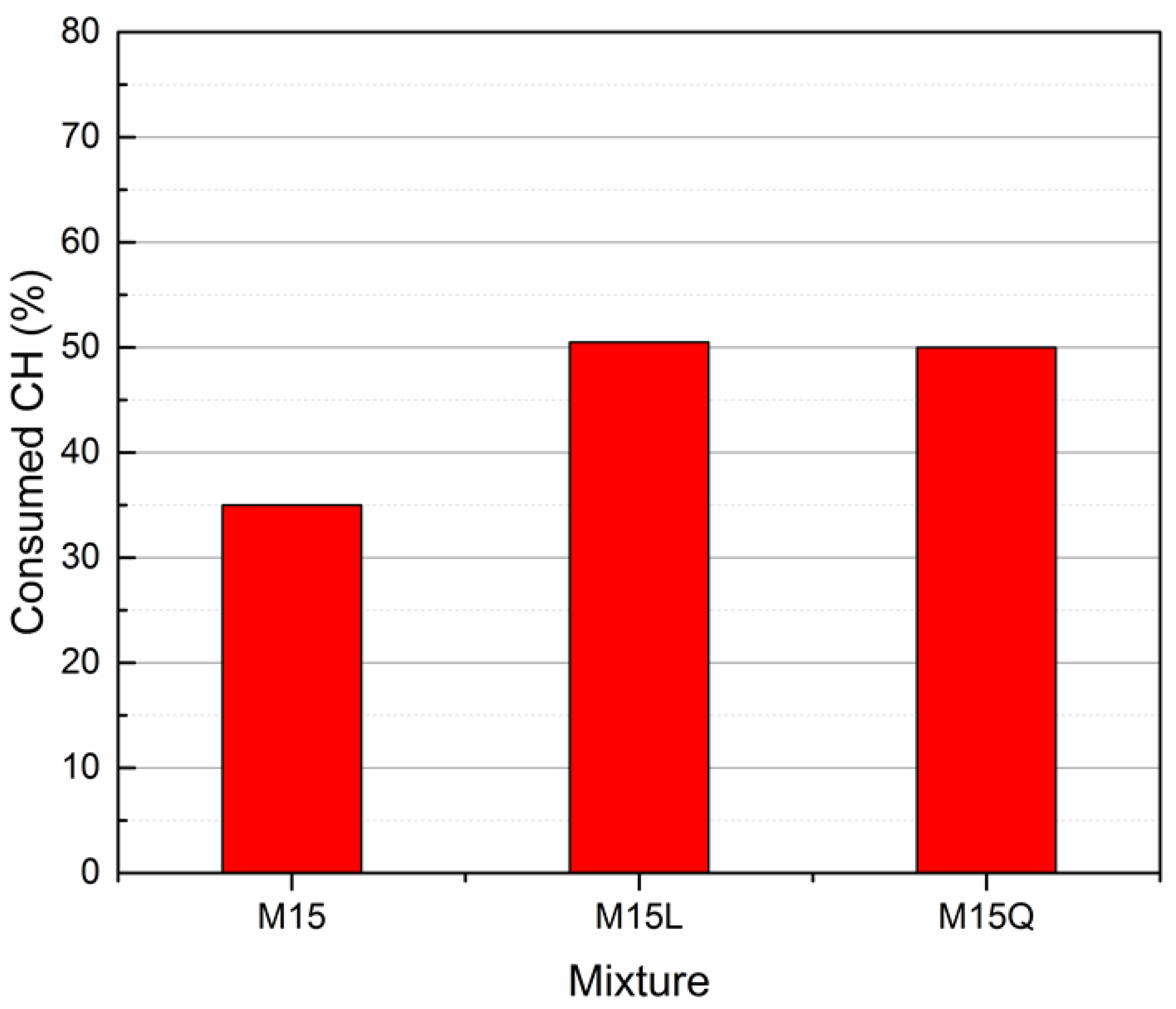
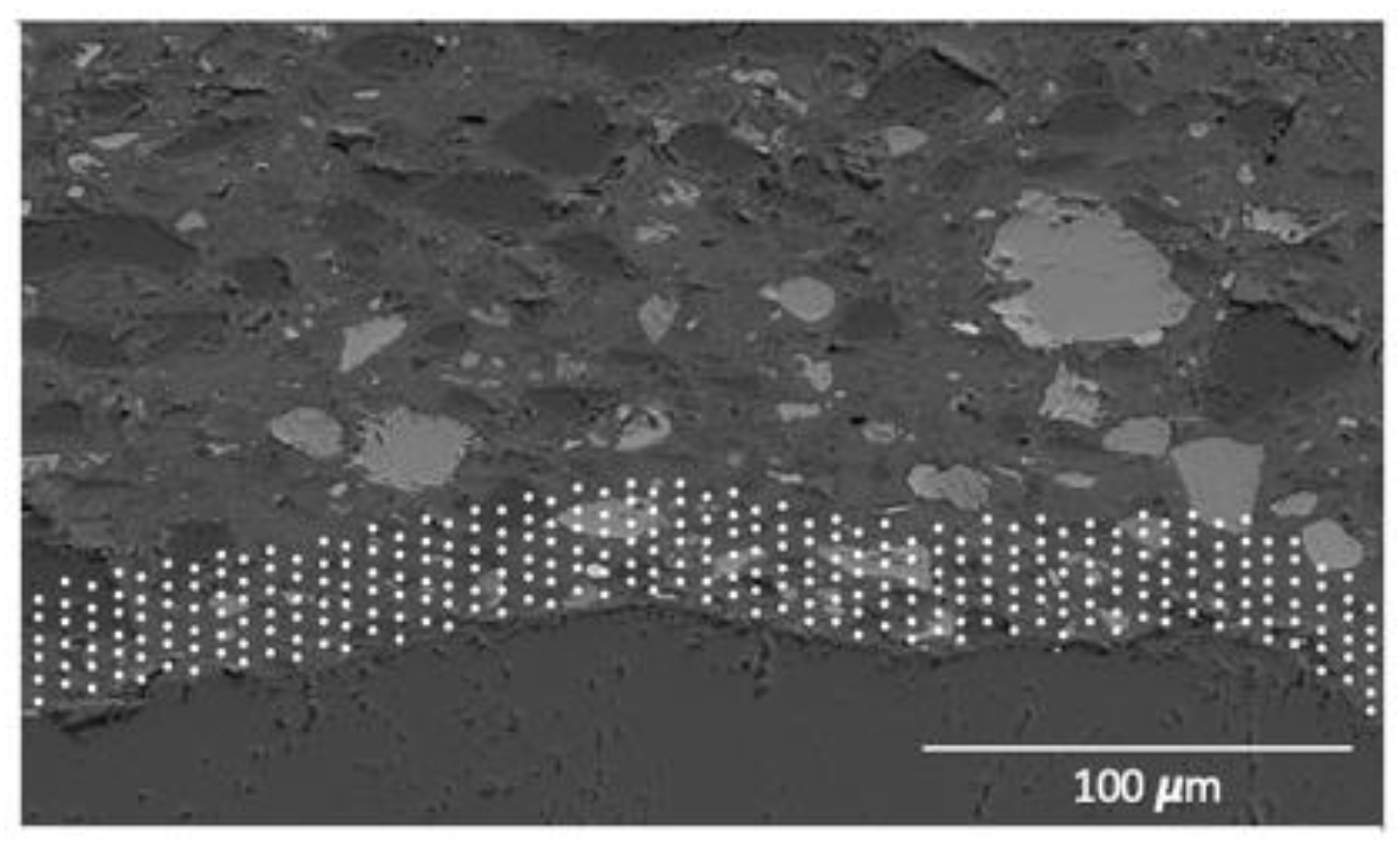

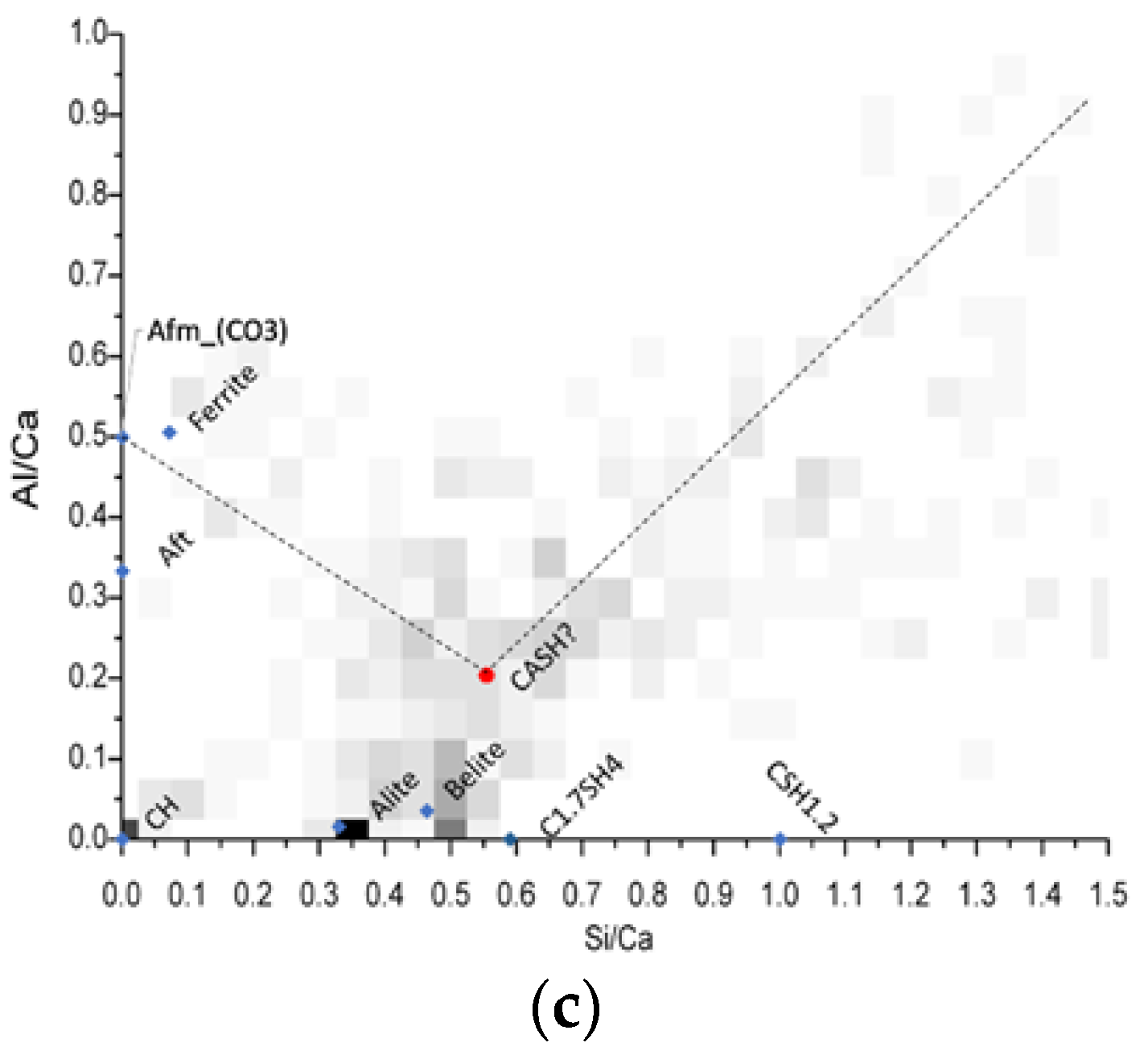
| Oxide Amount or Property (Weight, %) | Cementitious Materials | Powders | ||
|---|---|---|---|---|
| HS | MK | Q | LS | |
| SiO2 | 21.8 | 52.1 | 99.60 | 5.10 |
| TiO2 | 0.18 | 1.60 | 0.01 | 0.04 |
| Al2O3 | 4.00 | 44.4 | 0.10 | 0.80 |
| Fe2O3 | 3.14 | 0.40 | 0.02 | 0.27 |
| Mn2O3 | 0.038 | ----- | 0.002 | 0.008 |
| MgO | 1.90 | 0.10 | 0.10 | 1.30 |
| CaO | 63.10 | ----- | ----- | 51.20 |
| Na2O | 0.05 | 0.10 | ----- | ----- |
| K2O | 0.56 | 0.10 | ----- | 0.34 |
| P2O5 | 0.09 | ----- | ----- | 0.01 |
| SO3 | 2.37 | ----- | ----- | 0.06 |
| SrO | 0.10 | ----- | ----- | 0.03 |
| ZnO | 0.02 | ----- | ----- | ----- |
| Loss of ignition | 2.60 | 1.0 | 0.10 | 40.90 |
| Equivalent alkali (Na2Oeq) | 0.42 | 0.20 | ----- | 0.22 |
| Density, g/cm3 | 3.18 | 2.59 | 2.75 | 2.71 |
| Blaine surface, m2/kg | 438.00 | ----- | ----- | ----- |
| BET surface, m2/g | ----- | 10.66 | ----- | ----- |
| Mean particle size (d50), μm | 14.00 | 4.10 | 19.00 | 17.00 |
| Chemical Phase (wt %) | HS | MK | L |
|---|---|---|---|
| C3S | 52.0 | ----- | ----- |
| C2S | 18.0 | ----- | ----- |
| C3A cubic | 1.0 | ----- | ----- |
| C3A orthorhombic | 2.0 | ----- | ----- |
| Ferrite | 10 | ----- | ----- |
| Periclase | 1.0 | ----- | ----- |
| Gypsum | 1.0 | ----- | ----- |
| Bassanite | 3.0 | ----- | ----- |
| Calcite | 5.0 | ----- | 75.0 |
| Quartz | ----- | ----- | 3.0 |
| Anatase | ----- | 2.0 | ----- |
| Dolomite | ----- | ----- | 3.0 |
| Amorphous | 7.0 | 98.0 | 19.0 |
| Material, Parameter or Property | Mixtures | |||||||||||
|---|---|---|---|---|---|---|---|---|---|---|---|---|
| M5 | M5L | M5Q | M10 | M10L | M10Q | M15 | M15L | M15Q | M20 | M20L | M20Q | |
| w/c weight ratio | 0.25 | 0.40 | 0.40 | 0.25 | 0.40 | 0.40 | 0.25 | 0.40 | 0.40 | 0.25 | 0.40 | 0.40 |
| MK by weight of cement | 0.05 | 0.08 | 0.08 | 0.1 | 0.16 | 0.16 | 0.15 | 0.24 | 0.24 | 0.2 | 0.32 | 0.32 |
| Water (kg/m3) | 199 | 199 | 200 | 199 | 199 | 200 | 199 | 199 | 200 | 200 | 200 | 200 |
| HS (kg/m3) | 797 | 499 | 500 | 797 | 499 | 500 | 798 | 499 | 500 | 800 | 500 | 500 |
| L (kg/m3) | --- | 250 | --- | --- | 250 | --- | --- | 251 | --- | --- | 256 | --- |
| Q (kg/m3) | --- | --- | 245 | --- | --- | 245 | --- | - | 245 | --- | --- | 259 |
| MK (kg/m3) | 40 | 40 | 40 | 80 | 80 | 80 | 120 | 120 | 120 | 160 | 160 | 160 |
| Solids in HRWRA (kg/m3) | 12 | 9 | 9 | 12 | 9 | 9 | 12 | 9 | 9 | 14 | 11 | 11 |
| Sand (kg/m3) | 1369 | 1377 | 1381 | 1328 | 1336 | 1339 | 1287 | 1296 | 1298 | 1239 | 1246 | 1246 |
| Unit weight (kg/m3) | 2436 | 2407 | 2399 | 2421 | 2390 | 2397 | 2424 | 2380 | 2378 | 2352 | 2330 | 2318 |
| Air content before vibration (%) | 1.0 | 1.0 | 1.0 | 2.0 | 1.0 | 1.0 | 2.0 | 2.0 | 2.0 | 3.0 | 2.0 | 3.0 |
| Air content after vibration (%) | 0.0 | 0.0 | 0.0 | 0.0 | 0.0 | 0.0 | 0.0 | 0.0 | 0.0 | 2.0 | 0.0 | 0.0 |
| Mini cone Spread without vibration (cm) | 30 | 32 | 33 | 28 | 31 | 33 | 27 | 30 | 32 | 24 | 28 | 27 |
| Phase | Mixtures | ||
|---|---|---|---|
| M15 | M15L | M15Q | |
| C3S | 15.0% | 6.0% | 7.0% |
| C2S | 6.0% | 3.0% | 4.0% |
| C4AF | 3.0% | 2.0% | 2.0% |
| Calcite | 3.0% | 20.0% | 1.0% |
| Calcium Hydroxide | 5.0% | 3.0% | 3.0% |
| Ettringite | 4.0% | 3.0% | 3.0% |
| Quartz | ----- | ----- | 25.0% |
| Bassanite | ----- | 1.0% | ----- |
| Gypsum | 1.0% | 1.0% | 1.0% |
| Monocarbonate | 0.00% | 0.10% | 0.20% |
| Amorphous content/CSH | 62.0% | 62.0% | 53.0% |
| Mixture | Ca/Si | Al/Ca | S/Ca | Fe/Ca | ||||
|---|---|---|---|---|---|---|---|---|
| M15 | 1.82 | ±0.05 | 0.25 | ±0.01 | 0.06 | ±0.01 | 0.03 | ±0.02 |
| M15L | 1.82 | ±0.05 | 0.25 | ±0.02 | 0.04 | ±0.02 | 0.03 | ±0.03 |
| M15Q | 1.80 | ±0.05 | 0.20 | ±0.04 | 0.03 | ±0.01 | 0.04 | ±0.06 |
Publisher’s Note: MDPI stays neutral with regard to jurisdictional claims in published maps and institutional affiliations. |
© 2022 by the authors. Licensee MDPI, Basel, Switzerland. This article is an open access article distributed under the terms and conditions of the Creative Commons Attribution (CC BY) license (https://creativecommons.org/licenses/by/4.0/).
Share and Cite
Hernández-Carrillo, G.; Durán-Herrera, A.; Tagnit-Hamou, A. Effect of Limestone and Quartz Fillers in UHPC with Calcined Clay. Materials 2022, 15, 7711. https://doi.org/10.3390/ma15217711
Hernández-Carrillo G, Durán-Herrera A, Tagnit-Hamou A. Effect of Limestone and Quartz Fillers in UHPC with Calcined Clay. Materials. 2022; 15(21):7711. https://doi.org/10.3390/ma15217711
Chicago/Turabian StyleHernández-Carrillo, Guillermo, Alejandro Durán-Herrera, and Arezki Tagnit-Hamou. 2022. "Effect of Limestone and Quartz Fillers in UHPC with Calcined Clay" Materials 15, no. 21: 7711. https://doi.org/10.3390/ma15217711
APA StyleHernández-Carrillo, G., Durán-Herrera, A., & Tagnit-Hamou, A. (2022). Effect of Limestone and Quartz Fillers in UHPC with Calcined Clay. Materials, 15(21), 7711. https://doi.org/10.3390/ma15217711






